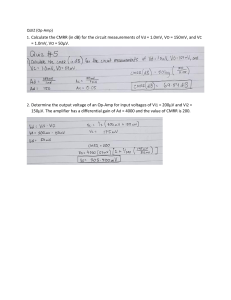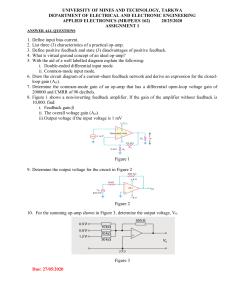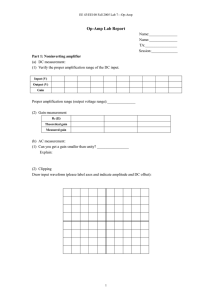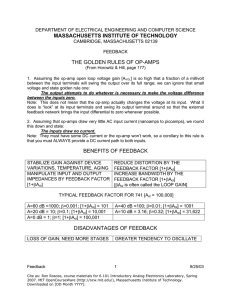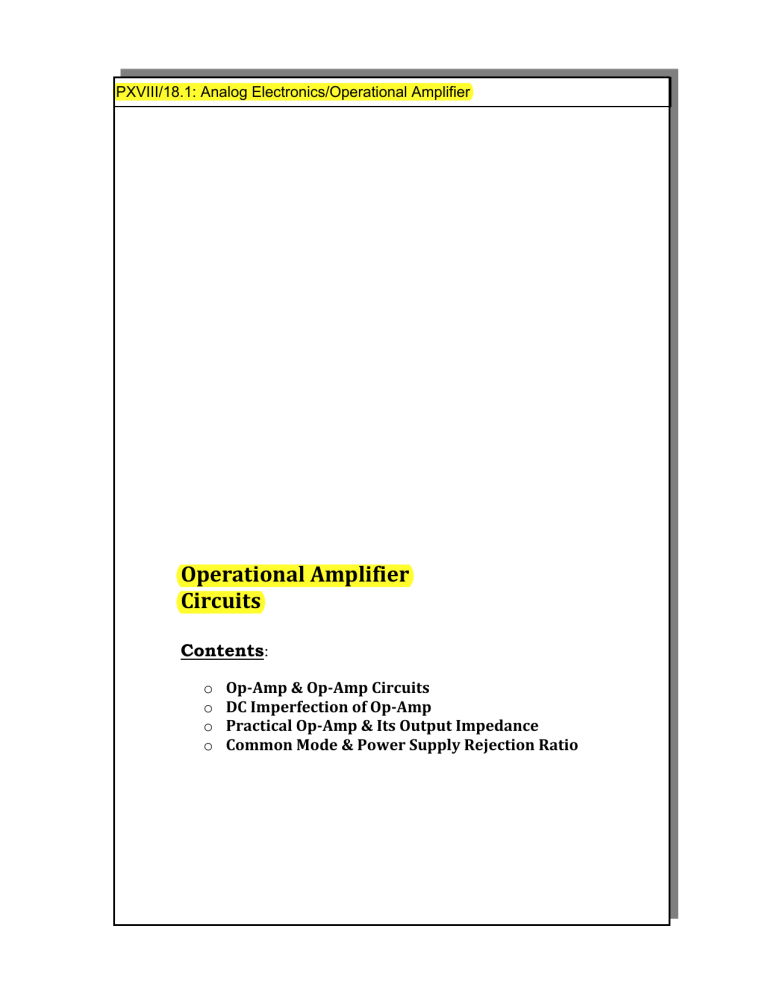
PXVIII/18.1: Analog Electronics/Operational Amplifier
Operational Amplifier
Circuits
Contents:
o
o
o
o
Op-Amp & Op-Amp Circuits
DC Imperfection of Op-Amp
Practical Op-Amp & Its Output Impedance
Common Mode & Power Supply Rejection Ratio
Op-Amp & Op-Amp Circuits
Operational Amplifier (Op-Amp)
An operational amplifier is a direct coupled amplifier with two differential inputs and a single
output. It is a versatile device used in almost all analog circuits. It provides very high open
loop gain. It is a linear active device, which consists of different stages as show in figure.
+VCC=15V
1
-
V1
3
2
O/P
+
V2
-VCC=-15V
Fig: Circuit Symbol With Power
Supply Connection
+VCC=15V
1
I/P
2
+
Stage
1
Stage
2
Stage
3
Stage
4
O/P
-VCC=-15V
Fig: Different Stages of Operational
Amplifier
Stages:
It was originally designed for performing mathematical operation such as, summation,
subtraction, multiplication, differentiation, integration, sigh changing etc. Now-a-days it has
numerous usages e.g. scale changing analog computer operation, in instrumentation and
control system and in various phase-shift and oscillator circuits.
26
Differential Amplifier with Double Ended Output
Differential Amplifier with Single Ended Output
Level Shifting Amplifier
Emitter Follower Output Stage
Page
1.
2.
3.
4.
Stage 1:
It is a differential amplifier with a non-inverting and an inverting input terminal. It has also
double ended output. It has very high input impedance, so it amplifies very small signals
applied differentially and rejects small and large common mode input signal.
Stage 2:
It is a medium level signal amplifier biased by constant current source. Its output is a single
ended. So that it could be conveniently cascaded to the follower circuits.
Stage 3:
It is a common emitter amplifier which is responsible for level shifting as well as
amplification
Stage 4:
It is basically emitter follower type circuit to obtain low output impedance and high current
gain. So that it could drive the external load approximately.
Technical Characteristics: Ideal Vs. Practical Op-Amp
S.N.
1
2
3
4
5
6
7
8
Characteristics
Practical Op-Amp (NE 741)
Voltage Gain (Open Loop)
Input Resistance (Rin)
Output Resistance (Rout)
Input Bias Current
Input Offset Current
Input Offset Voltage
Unity Gain Band-Width
Slew Rate
5
10
106
75
200 nA
20 nA
2mV
1 MHz
0.7 µV/sec
Ideal Op-Amp
0
0
0
0
0 to
Ideal Operational Amplifier
The Op-amp is designed to sense and amplify the difference between the voltages signal
applied at its two input terminals. The output of Op-amp is:
Vo
27
Open loop gain.
Voltage between terminal 2 and ground, and
Voltage between terminal 1 and ground.
Page
Where, A =
V2 =
V1 =
= A(V2-V1)
Characteristics of Ideal Operational Amplifier
1. The input impedance of an ideal Op-amp is
infinity, i.e. the signal current into terminal
one and two both are zero.
I1=0
V1
Vout
V2
2. The output impedance of an ideal Op-amp
is zero, i.e. the output voltage with respect to
ground is always equal to VO = A(V2-V1)
and is independent of the load.
I2=0
+
Fig: Ideal Op-Amp with Zero Signal
Current Due to Infiniter I/P Impedance
I1=0
V1
A(V2-V1)
+
-
3. It has infinite common mode rejection, i.e.
it ignores any signal common to both inputs.
I2=0
V2
4. Ideal Op-amp has infinite band width, i.e. it
has gain ‘A’ that remains constant down to
zero frequency up to infinite frequency.
Vo
+
Fig: Ideal Op-Amp with
Zero o/P Impedance
Virtual Short Circuit & Virtual Ground
If the Op-amp has infinite open loop gain, i.e. A→∞; and producing finite voltage at output,
then voltage between the Op-amp input terminals should be negligibly constant as shown.
Vout = A(V2 − V1 )
i.e. V2 − V1 =
Vout
A
i.e. V2 − V1 = 0
i.e. V2 = V1
V1
=
-
∞
A
Vout
A
V2
+
Fig: Virtual Short-Circuit &
Virtual Ground
Page
If terminal two is grounded, voltage at terminal one is zero volts, so we call the terminal one
as a virtual ground.
28
This means that, Gain (A) → ∞; the voltage V1→V2, we call this as two input terminal
‘Tracking Each Other in Potential’ or ‘Virtual Short Circuit’ exists between the two input
terminals. A virtual short circuit means that whatever voltage is at terminal two, will
automatically appear at terminal one because of infinite gain.
Op-Amp Circuits
1. Inverting Configuration
In this configuration input is supplied on the inverting terminal of the op-amp, so called
inverting configuration. R2 closes loop around the op-amp, so acts as a negative feedback.
R2
i2
R1
V1
1
-
i1
Vi
A
V2=0
2
Vo
+
Fig: Op-Amp Inverting Configuration
Calculation of closed loop gain:
Case I: If A → Infinite (∞);
From short circuit theory: V2 = 0 = V1 and also i1 = i2 … (i)
As,
(Vi −V1 )
R1
= i1
Vi
i.e.
R1
= i1 … (ii)
Again, V1 = i2 R 2 − Vo = 0
V
Or, Vo = V1 − i2 R 2 = −i1 R 2 = − R i . R 2
1
Closed loop gain (A) =
Vo
Vi
=−
R2
R1
Case II: If A → Finite;
i. e. V1 = −
(Vi −V1 )
Vo
A
… (i) (V2 = 0, but V1 V2)
V
… ii
and also,
i1 = i2 =
Again
Vo = V1 − i2 R 2 = V1 − i1 R 2 = −
Vo (1 + +
i.e.
Gain:
Vo
Vi
=
R
− 2
1
R1
1R
(1+A+AR2 )
1
1 R2
)
A R1
=
R1
Vo
A
V
−
Vi + Ao
R1
R2 = −
Vo
A
R
− Vi R 2 −
1
Vo R 2
A R1
R
= −Vi R2
1
R
− 2
1
R1
R
1+A(1+R2 )
1
29
1
A
R1
=
Vi + Ao
Page
Then, Vo = A(V2 − V1 )
2. Non Inverting Configuration
Here, input is fed into the non-inverting terminal-2 of an op-amp, so called non-inverting
configuration.
R2
i2
R1
V1
1
-
i1
A
V2
Vi
2
Vo
+
Fig: Op-Amp Non Inverting Configuration
Calculation of closed loop gain:
Case I: If A → Infinite (∞);
From short circuit theory: V1 = Vi
As,
(0−V1 )
R1
= i1
i.e. i1 = −
Vi
R1
i1 = i2 … (i)
and also,
= i1 … (ii)
Again, V1 = i2 R 2 − Vo = 0
V
Or, Vo = V1 − i2 R 2 = Vi − i1 R 2 = Vi + R i . R 2
1
Or, Vo = Vi (1 +
R2
R1
)
Closed loop gain (A) =
Vo
Vi
=1+
R2
R1
Case II: If A → Finite;
Then, Vo = A(V2 − V1 ) = A(Vi − V1 )
i. e. Vi − V1 =
Vo = V1 − i2 R 2 = V1 − i1 R 2 = Vi −
Vi
=
1
R1
1R
(1+A+AR2 )
1
=
A
…(i)
R1
Vo
A
V
+
Vi − Ao
R1
R 2 = Vi −
Vo
A
−
Vo R 2
A R1
R
+ V𝑖 R 2
1
R
= Vi (1 + R2)
1
R
(1+ 2 )
1
R1
R
1+A(1+R2 )
1
30
Vo
R
− 2
Vo
Page
Gain:
R1
1 R2
)
A R1
i. e. V1 = Vi −
… (ii)
Again
1
A
=
−Vi + Ao
i1 = i2 =
Vo (1 + +
A
V
(0−V1 )
and also,
i.e.
Vo
Design an operational amplifier having:
a) Vo = -10Vi and
b) Vo = 5Vi
Solution:
a) When Vo = -10Vi
i.e. Gain (A) = Vo/Vi = -10
Since, it has negative voltage gain, so using a inverting configuration of op-amp, in
which, Vo = -(R2/R1)Vi
i.e. A = Vo/Vi = -R2/R1
i.e. -10 = -R2/R1
i.e. R2 = 10R1
Let; R1 = 10K, then R2 = 1010 = 100K
Now, the resulting circuit of the op-amp looks like as follow in fig(a).
40K
100K
i2
i2
10K
Vi
V1
1
10K
-
V1
1
-
i1
A
i1
A
V2=0
2
+
Fig(a): Op-Amp Inverting Configuration
Vo
Vo
Vi
V2
2
+
Fig(b): Op-Amp Non Inverting Configuration
b) When Vo = 5Vi
i.e. Gain (A) = Vo/Vi = 5
Since, it has positive voltage gain, so using a non-inverting configuration of op-amp,
in which, Vo = (1+R2/R1)Vi
i.e. A = Vo/Vi = 1+R2/R1 = (R1+R2)/R1
i.e. 5 = (R1+R2)/R1
i.e. 5R1 – R1 = R2
i.e. R2 = 4R1
Page
31
Let; R1 = 10K, then R2 = 410 = 40K
Now, the resulting circuit of the op-amp looks like as in above fig(b).
3. The Voltage Follower
The non-inverting configuration has infinite input resistance. It enables using this circuit
as a buffer amplifier to connect a source with high impedance to low impedance. Buffer
amplifier has voltage gain of one.
Vi = V1
Vi = V1
-
-
Vo
A=1
A=1
V2
V2
+
Ro
+
Vi
Vo = Vi
Ri
Vi
Fig: Basic Connection of
Voltage Follower
Fig: Circuit Connection of
Voltage Follower
4. Integrator
It consists of a capacitor C in the feedback path of the inverting configuration.
Vc(t)
I2(t)
R1
1
Vi(t)
-
V1
I1(t)
Vo(t)
V2 = 0 2
+
Fig: Op-amp as an Integrator
From figure:
i1 =
ϑi(t) −ϑ1
R1
=
ϑi(t) −0
R1
; (V2 = 0 = V1)
i.e. i1 =
ϑi(t) −ϑ1
R1
=
ϑi(t)
R1
= i2 . …(i)
Again from loop equation:
V1 − ϑc(t) − ϑo(t) = 0
t
1
i.e. V1 − ∫0 i2(t) dt = ϑo(t)
C
1
t
i.e. 0 − ∫0 i2(t) dt = ϑo(t)
C
1
t
1
t ϑi(t)
i.e. ϑo(t) = − ∫0 i2(t) dt
C
dt
t
1
∫ ϑ dt
R1 C 0 i(t)
{ From … (i)}
32
i.e. ϑo(t) = −
R1
Page
= − ∫0
C
5. Differentiator
In this case, a capacitor C is connected in the inverting terminal -1 of the inverting
configuration of an operational amplifier. In which V2 = 0 = V1.
R
I2(t)
Vc(t)
-
Vi(t)
V1
I1(t)
Vo(t)
+
V2 = 0
Fig: Op-amp as a Differentiator
From figure:
ϑi(t) − ϑc(t) − V1 = 0
Since, i1(t) = C
dϑc(t)
dt
… (i) (V1 = 0)
i.e. ϑi(t) = ϑc(t)
=C
dϑi(t)
dt
= i2(t) … (ii)
Again from loop equation:
V1 − Ri2(t) − ϑo(t) = 0
i.e. ϑo(t) = −Ri2(t) = −RC
i.e. ϑo(t) = −RC
dϑi(t)
dt
dϑi(t)
dt
6. Difference Amplifier
Op-amp can be used in subtracting mode. The alongside figure shows a circuit that can
provide the difference between two inputs.
Rf
i2
Vi1
R1
1
-
V1
i1
A=1
V2
2
+
R3
Fig: Op-amp as a Substracter
33
i2
Page
Vi2
Vo
From figure, we have: V2 =
R3
V
R3 +R2 i2
As; Vi1 − i1 R1 − V1 = 0;
… (i)
= V1
i.e. i1 =
Vi1 −V1
R1
… (ii)
= i2
Again from loop equation:
V1 − i2 R f − V0 = 0
R3
V −V
V − i1 1 R f
R3 +R2 i2
R1
R3
Vi1
V1
V − R + Rf
R3 +R2 i2 R1 f
R1
R3
Rf
R
R
V − Vi1 + f 3 Vi2
R +R i2
R
R R +R
i.e. V0 = V1 − i2 R f =
=
=
3
2
1
1
3
2
Let: Rf/R1 = R3/R2; then:
V0 =
R3 /R2
R3 /R2 +R2
Vi2 −
=
Rf /R1
V
Rf /R1 +R2 i2
=
Rf
V
R1 +Rf i2
=
V0 =
Rf
R1 +Rf
Rf
R1
−
−
Rf
R1
Rf
V
R1 i1
Rf
V
R1 i1
Vi2 (1 +
Vi1 +
Rf
R1
+
)−
+
Rf
R3 /R2
V
R1 R3 /R2 +R2 i2
Rf Rf /R1
V
R1 Rf /R1 +R2 i2
Rf Rf
V
R1 R1 +Rf i2
Rf
R1
Vi1 =
Rf
R1 +Rf
R1 +Rf
Vi2 (
R1
)−
Rf
R1
Vi1 =
Rf
R1
Vi2 −
Rf
V
R1 i1
(Vi2 − Vi1 )
7. Comparator
Comparators are similar to Op-amp except that open loop gain is made longer by
including positive feedback in the internal circuit. Due to very large open loop gain,
output voltage essentially provides digital operation.
Vin > VR
Vo = Vmax
When,
then
Vin < VR
Vo = Vmin
-
VR
+
Vo
Fig: Comparator Circuit
Symbol
Vo
Vmax
VR
Vin
Vmin
Fig: Comparator Characteristics
Curve
34
When,
then
Vin
Page
There are only two possible outputs,
they are Vmax and Vmin.
Examples
1. If 𝛝𝐢(𝐭) = 5sin(t), R = 100K, C =
1µF, then 𝛝𝐨(𝐭) = ?
V1(t)=50cost
t
Solution:
We have: ϑo(t) = −
ϑo(t) = −
1
R1
t
1
∫ 5sin(t)dt
100×103 ×1×10−6 0
t
1
100×103 ×1×10−6
=
Vo(t)=50cost-50
t
=−
. 5cos(t)|
100×103 ×1×10−6
0
1
=−
-
V2(t)=5
0
t
∫ ϑ dt
C 0 i(t)
t
(5cost − 1)
ϑo(t) = 50cost − 50
Fig: The Output of Integrator
When Input is Sinusoidal
2. If Vi = 2V, RC = 1, then V0 = ?
Vi(t)=2
Solution:
t
We have: ϑo(t) = −
1
t
1
∫ ϑ dt
R1 C 0 i(t)
Vo(t)=2t
t
ϑo(t) = − ∫0 2dt
1
Slope = -2
t
= −2t|
0
t
Fig: The Output of Integrator
Subjected to Step Input
ϑo(t) = −2t
8. Weighted Summer
i1
V1
V3
Rf
1
i2
R
2
i3
i
V
Vo
R
3
+
Fig: Resistor Summing Network
35
V2
R
Page
It consists of a summing of currents
through the resistors at each branch
supplied with corresponding input
voltages. The summed current is fed to
the inverting terminal of an op-amp, to
which the output voltage V0, is feed
backed with resistor Rf as shown in figure
alongside.
i1 =
Here;
Similarly, i2 =
V1 −V
R1
V2
R2
=
; i3 =
V1 −0
R1
V3
R3
=
V1
R1
and so on.
At a junction; i = i1 + i2 + i3 + …. + in
i.e. i =
V1
+
R1
V2
R2
+
V3
R3
+⋯
Vn
Rn
…(i)
Again from loop equation:
V1 − iR f − V0 = 0
i.e. V0 = −iR f = −(
Where,
Rf Rf
,
R1 R2
…
Rf
R3
V1
R1
+
V2
R2
+
V3
R3
+⋯
Vn
)R f =
Rn
Rf
V
R1 1
+
Rf
V
R2 2
Rf
V
R3 3
+
+⋯
Rf
Rn
Vn
are known as the weights of V1, V2, …Vn respectively. Since, the output
voltage is the sum of all weights, so it is called by weighted summer.
Examples
1. Realize a circuit to obtain, Vo = -2V1+3V2+4V3. Use minimum value of R as 10K.
Solution:
Here; Vo = -2V1+3V2+4V3 = -{2V1+3(-V2)+4(-V3)} …(i)
Comparing (i) with the equation: V0 = −(
Rf
R1
= 2; i.e.
Rf
2
= R1 ;
Rf
R2
= 3; i.e.
Rf
3
Rf
R1
V1 +
= R 2 and
Rf
R2
Rf
R3
V2 +
Rf
V3 + ⋯
R3
Rf
= 4; i.e.
4
Rf
V );
Rn n
We get:
= R3
Here; R3<R2<R1; So, choosing R3 = 10K. Then: Rf = 4R3 = 410 = 40K, R1 = Rf/2 =
40/2 = 20K, R2 = Rf/3 = 40/3 = 13.33K. Now, the realization of the circuit is as follow.
10K
i1
V1
10K
Rf = 40K
R1 = 20K
-
V2
i2
R2 = 13.3K
i
i
V
+
i3
Vo
R2 = 10K
10K
+
10K
-
V3
DC Imperfection of Op-Amp
Page
Fig: Realization of the Resistor Summing Network:
When Vo = -2V1+3V2+4V3
36
+
Output Offset Voltage
The actual value of output voltage when the inputs are zero is called the output offset voltage.
It is the output level about which the signal variation occurs. If an op-amp is used only for
an ac signal, it can be capacitor coupled to block the dc component represented by offset. On
the other hand, at low level and low frequency signal, the offset voltage creates the error, so
it has to be reduced.
Output offset voltages are the result of two distinct input phenomenons, they are;
a) Input bias current and
b) Input offset voltage.
Input Bias Current
In the first-stage of op-amp i.e. differential stage, some dc bias current must flow when
the transistor is properly biased. This current is called input bias current. Although, small
input bias current flowing through the external resistor in an amplifier circuit produces a
dc input voltage that in terms create an outpur offset voltage.
R2
R1
IB1
IB1
+
Vo (IB)
s
+
IB2
IB2
Fig(a): Input Bias Currents
IB1 & IB2
Fig(b): Output Offset Voltage
due to Input Bias Current
The input bias currents through two terminals are represented by two current sources IB1
and IB2 connected on two input terminals as shown below.
Generally, average input bias current is given by IB = (IB1 +IB2)/2 and the difference is
called input offset current, i.e. Iios = | IB1 - IB2|.
o Output offset voltage for closed loop configuration due to input bias current:
Referring fig (b)
Vos(IB) = R2IB1
… (i)
if R2 Vos Then: Gain (-R2/R1)
if R2 Gain Then: Vos
Where Vos = Output offset voltage.
o Reduction of output offset voltage due to input bias current:
Page
37
So,
This method consists of introducing a resistance R3 in series with the non-inverting
input load as shown below.
R2
R2
R1
-
R1
Vi1 = IB2R1
IB1
R3
Vo
Vo
+
R3
Vi2 = IB2R3
+
IB2
Vi2 = -IB2R3
Fig: Reduction of Output Offset Voltage due to Input Bias Current by Adding
Series Resistance R3 With Non-Inverting Input Load
Total output offset voltage (Vos) = Offset due to Vi1 + offset due to Vi2
i.e.
Vos = Vi1(-R2/R1) + Vi2(1+R2/R1) = -IB1R1(-R2/R1) + (-IB2R3)(1+R2/R1)
Putting Vos = 0 and assuming IB1 = IB2 = IB, then:
0
= IBR2 - IBR3(1+R2/R1)
i.e. R3
= R2/(1+R2/R1) = R1R2/(R1+R2) = R1 // R2
R3
= R1 // R2
Where R3 is called a compensation resistor.
Examples
1. Calculate the output offset voltage due to 300nA of bias current. How can you reduce
this offset voltage?
10K
100K
10K
-
10K
Vo
Vo
+
9.09K
Fig (a)
+
Fig (b)
Page
Now, the resulting circuit will be as give in above fig (b).
38
Solution:
Given; IB = 300 nA, i.e. IB1 = IB = 300 nA; R1 = 10K and R2 = 100K
a) VOS(IB) = R2.IB1 = 10010330010-9 = 0.3 mV
b) In order to reduce this offset voltage, an external resistance R3 should be connected
in series at terminal-2, for which R3 = R1//R2 = 10K//100K = 9.09K
Note: We have, R3 = R1//R2 (only for IB = IB1 = IB2). If IB1 IB2; it should be noted that
inserting R3 in terminal-2 cannot nullify the offset voltage but in this case output offset
voltage is given by: VOS = IOS.R2 = |IB1 – IB2|.R2
2. Given IB = 80nA, IOS = 10nA, R1 = 10K and R2 = 100K (Note: IB2>IB1)
Find:
a) Optimum value of compensation resistor.
b) Offset voltage with compensation resistor.
c) Offset voltage without compensation resistor.
Solution:
Since, IB = (IB1 + IB2)/2 = IB1 + IB2 = 802 = 160
And IOS = |IB1 - IB2| = | IB2 - IB1| = 10 … (ii)
Solving I and II, we get: IB1 = 75nA and IB2 = 85nA
… (i)
Now,
a) R3 = R1//R2 = 10K//100K = 9.09K
b) VOS = IOS.R2 = 1010-9100103 = 1mV
c) VOS(without R3) = IB1.R2 = 7510-9100103 = 7.5mV.
Input Offset Voltage
Another input phenomenon that contributes to output offset voltage as an internally
generated potential difference that exists because of imperfect matching of the input
transistors. This internally generated potential difference is called input offset voltage. In
another words, input offset voltage can be defined as the voltage required to supply
through the input to make the output offset voltage zero.
-
1
3
+
2
Vios
Input Offset
Voltage
Offset Free
Op-Amp
Page
The effect of this voltage can be analyzed by modeling op-amp as shown in above figure.
It consists of a dc source of value Vios placed in series with the input load of an offset free
op-amp.
39
Fig: Demonstration of
Input Offset Voltage
o Output offset voltage of a closed loop op-amp configuration due to input offset
voltage.
Here;
i1 = i2 and V1 = Vios
R2
i2
i1 = -V1/R1 = -Vios/R1
R1
-
Again;
Vos = V1 – i2R2
= Vios – i1R2
= Vios + Vios.(R2/R1)
Vos = Vios{1+(R2/R1)}
Vos
i1
+
Offset Free
Op-Amp
Vios
Fig: Demonstration of Output Offset Voltage of Closed
Loop Op-Amp Configuration Due to Input Offset Voltage
Hence; total offset voltage is given by:
Vtos = Offset voltage due to i/p bias current + Offset voltage due to i/p offset voltage
i.e. Vtos = IB1.R2 + Vios{1+(R2/R1)}
This is the case when compensation resistor is not used. When compensation resistor R3
is used, then:
Vtos
= IOS.R2 + Vios{1+(R2/R1)}; Where, R3 = R1/R2
Examples:
1. Given: R1 = 15K, R2 = 75K, IB = 100nA, IOs = 20nA, Vios = 0.5mV. Find Vtos when;
a) Compensation resistor is used under the assumption of i) IB1>IB2, ii) IB2>IB1.
b) Compensating resistor is not used as i) IB1>IB2, ii) IB2>IB1.
c) Find R3 ie; compensating resistor.
Solution:
a) When R3 is used:
Vos1 = Ios.R2 = 2010-975103 = 1.5 mV
Vos2 = Ios.{1+(R2/R1)} = 0.5(1+75/15) = 3 mV
Vtos = Vos1 + Vos2 = 3 + 1.5 = 4.5 mV (for both case i and ii)
b) When R3 is not used:
Page
Now; Vtos = Vos1 + Vos2
= IB1.R2 + 3mV
= 11010-975103 + 3mV = 11.25 mV
40
i) If IB1>IB2
Then, Ios = |IB1 - IB2| = 20 nA
i.e. IB1 – IB2 = 20nA …(i) and IB = (IB1+IB2)/2, i.e. IB1+IB2 = 200nA … (ii)
Solving i and ii, we get: IB1 = 110nA and IB2 = 90nA
ii) If IB1< IB2
Then, from similar calculation we get: IB1 = 90nA and IB2 = 110nA
Vtos = Vos1 + Vos2
= IB1.R2 + 3mV
= 9010-975103 + 3mV = 9.75 mV
c) Compensation resistor, R3 = R1 // R2 = 75K // 15K = 12.5K
Equivalent Model of Practical Op-Amp
2Ricm
iid
Rid
Vid
VO
RO
+
-
Icm
2
AVd
i
Icm
2
2Ricm
Fig(a): Equivalent Model
of Practical Op-Amp
R2
Icm
2
R2
2Ricm
R1
R1
V1
Vin
VO
Vid
Loop I
AVd
iin
Vin
+
Rid
RO
+
-
Rid
+
-
iid
RO
VO = AVid
AVid
iin
Fig(b): Before Considering
Assumption
Fig(c): After Considering
Assumption
41
2Ricm
Page
Icm
2
Legends:
Ricm
icm
Rid
iid
A
Ro
= Common mode resistance between terminal and ground
= Common mode current
= Differential resistance between two terminal.
= Differential current.
= Open loop gain of op-amp
= Output resistance of Op-amp
For input resistance of non-inverting configuration: R1 << Ricm
i.e. Ro 0 and 2Ricm >> Rid
Therefore, input impedance of non inverting configuration is very high while that of inverting
configuration is very low.
V1 =
Referring fig: c)
If
R1
R1 +R2
R1
R1 +R2
× VO
= ; then: V1 = βVo …(i)
From loop I
Vin − iin R id − V1 = 0
i.e. Vin = Vid + V1
Now;
Rin = Input terminal resistance = input voltage/input current
i.e. Rin = Vin/iin
i.e. R in =
i.e. R in =
Vid +V1
iid
=
Vid +V1
Vid /Rid
=
Vid +βVo
Vid /Rid
=
Vid +βAVid
Vid /Rid
=
(1+Aβ)Vid
Vid Rid
=
(1+Aβ)
Rid
(1+Aβ)
Rid
Output Impedance of Closed Loop Op-Amp
To find output resistance, input sources are made short and grounded. Applying a test voltage
at output resistance, Rout = Vx/Ix.
Let us assume, Ricm and Rid >> R1
R1 +R2
× Vx = β Vx
At junction ‘O’ ix = i1 + i2
i.e. V1 = β Vx …(i)
…(ii)
42
R2
Page
Now;
V1 =
i.e. Rid//R1 = R1
But:
i1 =
i2 =
Vx
=
R1 //Rid +R2
Vx −AVd
and
Vx −A(0−V1 )
=
Ro
Vx
R1 +R2
Ro
=
Vx +AV1
=
Ro
Vx +AβVx
Ro
=
Vx
Ro
(1 + Aβ)
R2
Vx
R1
i1
-
V1
Vin
RO
Rid
Vx
AVid
+
R2
i2 ix
o
+
-
Vid
Loop I
R1
Rid
Fig(c): Output Impedance of
a Colsed Loop Op-Amp
ix = i1 + i2
i.e.
ix =
i.e.
i.e.
i.e.
ix
Vx
Vx
R1 +R2
=
1
Rout
+
1
R1 +R2
=
Vx
Ro
+
1
R1 +R2
(1 + Aβ) = Vx {
1
R1 +R2
+
(1+Aβ)
Ro
}
(1+Aβ)
+
Ro
1
Ro /(1+Aβ)
R out = (R1 + R 2 )//{R o /(1 + Aβ)}
If gain is high then: Ro/(1+AB) becomes low.
≫ (R1 + R 2 )
So, for parallel case; R out = R o /(1 + Aβ)
43
1
Ro /(1+Aβ)
Page
i.e.
Common Mode Rejection Ratio (CMRR)
The operational amplifier basically operates to amplify the difference between the signals
applied across its two terminals i.e. it is intended to operate in differential mode. So, when
input terminals are tied together, the output voltage should be ideally zero but due to some
imperfections within an actual op-amp, some common mode voltage will appear at the
output. The ratio of output common mode voltage to input common mode voltage is called
common mode voltage gain.
i.e. ACM =
Vocm
Vicm
Now;
CMRR is defined as the ration of differential gain Ad to common mode gain Acm.
i.e. CMRR =
Ad
Acm
Since, Ad >> Acm, CMRR is very high, so it is expressed in dB.
Ad
i.e. CMRR = 20 log(
Acm
)dB
Typically CMRR ranges from 80dB to 100dB. The op-amps with high CMRR will be least
affected by noise signals, that are common to both terminals because of higher ability to
reject the common mode signals.
Output voltage in terms of CMRR
Since, Output voltage = Output voltage due to differential mode + Output voltage due
to common mode
i.e. Vo = Ad Vd (1 +
Acm Vicm
Ad
.
Vd
) = Ad Vd (1 +
1
CMRR
.
Vicm
Vd
)
Where;
Ad = Differential Gain
Vd = Differential Voltage
Acm = Common mode gain
Vicm = Common mode input voltage
Page
The input terminals of an op-amp are connected to voltage signals of strength 745 µV and
740 µV respectively. The gain of the op-amp in differential mode is 5105 and its CMRR is
80 dB. Calculate the output voltage and percentage error due to common mode.
44
Example
Solution
Vd = |V2 – V1| = |740-745| = 510-6 V
Ad = 5105 and CMRR = 80dB
1
As: . Vo = Ad Vd (1 +
CMRR
.
Vicm
Vd
) = 5105 × 510−6 (1 +
1
.
Vicm
CMRR 510−6
)
Where, Vicm = Vcm = (740+745)/2 = 742.5 µV and
(CMRR)dB = 20log(CMRR)
i.e. 80
= 20log(CMRR)
i.e. CMRR = 104
Vo = 5105 × 510−6 (1 +
%-age error =
=
1
104
.
742.510−6
510−6
) = 2.537V
Output Voltage due to common mode
Total Output Voltage
Vcm ×Acm
2.537
× 100
× 100
A
=
=
d
Vcm ×CMRR
2.537
× 100
5105
104
742.5×
2.537
× 100 = 1.46%
Power Supply Rejection Ratio (PSRR)
PSRR is defined as the ration of change in output voltage to change in power supply.
i.e. PSRR =
∆VO
∆VS
Page
45
PSRR is considered as the measure of ability of op-amp to ignore changes in power supply.
View publication stats
